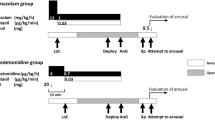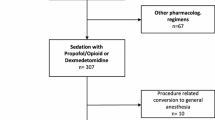Abstract
Purpose
This study aimed to compare the hemodynamic effects of remimazolam- and propofol-based total intravenous anesthesia in patients who underwent transcatheter aortic valve replacement.
Methods
This was a single-center, single-blind, randomized controlled trial set at Nara Medical University, Kashihara, Japan. We included 36 patients aged ≥ 20 years scheduled to undergo elective transfemoral transcatheter aortic valve replacement (TAVR) under general anesthesia. The participants were randomly assigned to the remimazolam and propofol groups (n = 18 each). Remimazolam- or propofol-based total intravenous anesthesia was initiated at 12 mg/kg/min or 2.5 mcg/mL via target-controlled infusion, respectively, along with remifentanil. After confirming the loss of consciousness, the administration rate was adjusted using electroencephalographic monitoring. The primary outcome was the rate of arterial hypotension, defined as a mean arterial pressure < 60 mmHg, from anesthesia induction until the beginning of the surgical incision. The total doses of ephedrine and phenylephrine were also assessed.
Results
During anesthesia induction, the arterial hypotension rates were 11.9% and 21.6% in the remimazolam and propofol groups, respectively (P = 0.01). The total dose of ephedrine was higher in the propofol group (14.4 mg) than in the remimazolam group (1.6 mg) (P < 0.001); however, the total dose of phenylephrine was not significantly different between the two groups (propofol 0.31 mg vs. remimazolam: 0.17 mg, P = 0.10).
Conclusion
Remimazolam-based total intravenous anesthesia resulted in a lower hypotension rate than propofol-based total intravenous anesthesia during induction in patients undergoing TAVR. Remimazolam-based total intravenous anesthesia can be used safely during anesthetic induction in patients with severe aortic stenosis.


Similar content being viewed by others
Data availability
The data supporting the findings of this study are available from the corresponding author upon reasonable request.
References
Maheshwari K, Turan A, Mao G, Yang D, Niazi AK, Agarwal D, Sessler DI, Kurz A. The association of hypotension during non-cardiac surgery, before and after skin incision, with postoperative acute kidney injury: a retrospective cohort analysis. Anaesthesia. 2018;73:1223–8.
Südfeld S, Brechnitz S, Wagner JY, Reese PC, Pinnschmidt HO, Reuter DA, Saugel B. Post-induction hypotension and early intraoperative hypotension associated with general anaesthesia. Br J Anaesth. 2017;119:57–64.
Jor O, Maca J, Koutna J, Gemrotova M, Vymazal T, Litschmannova M, Sevcik P, Reimer P, Mikulova V, Trlicova M, Cerny V. Hypotension after induction of general anesthesia: occurrence, risk factors, and therapy. A prospective multicentre observational study. J Anesth 2018;32:673–680.
Ehret C, Rossaint R, Foldenauer AC, Stoppe C, Stevanovic A, Dohms K, Hein M, Schälte G. Is local anaesthesia a favourable approach for transcatheter aortic valve implantation? A systematic review and meta-analysis comparing local and general anaesthesia. BMJ Open. 2017;7: e016321.
Sundt TM, Jneid H. Guideline update on indications for transcatheter aortic valve implantation based on the 2020 American College of Cardiology/American Heart Association guidelines for management of valvular heart disease. JAMA Cardiol. 2021;6:1088–9.
Fassl J. Pro: Transcatheter aortic valve implantation should be performed with general anesthesia. J Cardiothorac Vasc Anesth. 2012;26:733–5.
Nakanishi T, Sento Y, Kamimura Y, Tsuji T, Kako E, Sobue K. Remimazolam for induction of anesthesia in elderly patients with severe aortic stenosis: a prospective, observational pilot study. BMC Anesthesiol. 2021;21:306.
Peng X, Liu C, Zhu Y, Peng L, Zhang X, Wei W, Zhu T. Hemodynamic influences of remimazolam versus propofol during the induction period of general anesthesia: a systematic review and meta-analysis of randomized controlled trials. Pain Physician. 2023;26:E761–73.
Wu X, Wang C, Gao H, Bai X, Zhang Z, Chen R, Huang X, An L, Yi J, Tong R. Comparison of remimazolam and propofol about safety outcome indicators during general anesthesia in surgical patients: a systematic review and meta-analysis. Minerva Anestesiol. 2023;89:553–64.
Zhang J, Cairen Z, Shi L, Pang S, Shao Y, Wang Y, Lu Z. Remimazolam versus propofol for procedural sedation and anesthesia: a systemic review and meta-analysis. Minerva Anestesiol. 2022;88:1035–42.
Schulz KF, Altman DG, Moher D, CONSORT Group. CONSORT. statement: updated guidelines for reporting parallel group randomized trials. BMJ. 2010;2010(340): c332.
Nakatani S, Ida M, Uyama K, Kinugasa Y, Kawaguchi M. Prevalence of pre-operative undiagnosed cognitive impairment and its association with handgrip strength, oral hygiene, and nutritional status in older elective surgical patients in Japan. J Anesth. 2023;37:64–71.
Chow WB, Rosenthal RA, Merkow RP, Ko CY, Esnaola NF, American College of Surgeons National Surgical Quality Improvement Program, American Geriatrics Society. Optimal preoperative assessment of the geriatric surgical patient: a best practices guideline from the American College of Surgeons National Surgical Quality Improvement Program and the American Geriatrics Society. J Am Coll Surg 2012;215:453–466.
Borson S, Scanlan J, Brush M, Vitaliano P, Dokmak A. The mini-cog: a cognitive ‘vital signs’ measure for dementia screening in multi-lingual elderly. Int J Geriatr Psychiatry. 2000;15:1021–7.
Kaiser MJ, Bauer JM, Ramsch C, Uter W, Guigoz Y, Cederholm T, Thomas DR, Anthony P, Charlton KE, Maggio M, Tsai AC, Grathwohl D, Vellas B, Sieber CC, MNA-International Group. Validation of the mini nutritional assessment short-form (MNA-SF): a practical tool for identification of nutritional status. J Nutr Health Aging. 2009;13:782–788.
Naylor AJ, Sessler DI, Maheshwari K, Khanna AK, Yang D, Mascha EJ, Suleiman I, Reville EM, Cote D, Hutcherson MT, Nguyen BM, Elsharkawy H, Kurz A. Arterial catheters for early detection and treatment of hypotension during major noncardiac surgery: a randomized trial. Anesth Analg. 2020;131:1540–50.
Nakatani H, Naito Y, Ida M, Sato M, Okamoto N, Nishiwada T, Kawaguchi M. Association between intraoperative hypotension and postoperative nausea and vomiting: a retrospective analysis of 247 thyroidectomy cases. Braz J Anesthesiol. 2023;73:635–40.
Sessler DI, Bloomstone JA, Aronson S, Berry C, Gan TJ, Kellum JA, Plumb J, Mythen MG, Grocott MPW, Edwards MR, Miller TE, Perioperative Quality Initiative-3 workgroup, POQI chairs, Miller TE, Mythen MG, Grocott MP, Edwards MR, Physiology group, Preoperative blood pressure group, Intraoperative blood pressure group, Postoperative blood pressure group. Perioperative Quality Initiative consensus statement on intraoperative blood pressure, risk and outcomes for elective surgery. Br J Anaesth 2019;122:563–574.
Galvin EM, Niehof S, Verbrugge SJ, Maissan I, Jahn A, Klein J, van Bommel J. Peripheral flow index is a reliable and early indicator of regional block success. Anesth Analg. 2006;103:239–43.
Toyama S, Kakumoto M, Morioka M, Matsuoka K, Omatsu H, Tagaito Y, Numai T, Shimoyama M. Perfusion index derived from a pulse oximeter can predict the incidence of hypotension during spinal anaesthesia for Caesarean delivery. Br J Anaesth. 2013;111:235–41.
Ely EW, Inouye SK, Bernard GR, Gordon S, Francis J, May L, Truman B, Speroff T, Gautam S, Margolin R, Hart RP, Dittus R. Delirium in mechanically ventilated patients: validity and reliability of the Confusion Assessment Method for the Intensive Care Unit (CAM-ICU). JAMA. 2001;286:2703–10.
Doi M, Morita K, Takeda J, Sakamoto A, Yamakage M, Suzuki T. Efficacy and safety of remimazolam versus propofol for general anesthesia: a multicenter, single-blind, randomized, parallel-group, phase IIb/III trial. J Anesth. 2020;34:543–53.
Sekiguchi R, Kinoshita M, Kawanishi R, Kakuta N, Sakai Y, Tanaka K. Comparison of hemodynamics during induction of general anesthesia with remimazolam and target-controlled propofol in middle-aged and elderly patients: a single-center, randomized, controlled trial. BMC Anesthesiol. 2023;23:14.
Doi M, Hirata N, Suzuki T, Morisaki H, Morimatsu H, Sakamoto A. Safety and efficacy of remimazolam in induction and maintenance of general anesthesia in high-risk surgical patients (ASA Class III): results of a multicenter, randomized, double-blind, parallel-group comparative trial. J Anesth. 2020;34:491–501.
Senn S. Testing for baseline balance in clinical trials. Stat Med. 1994;13:1715–26.
Nakasuji M, Nakasuji K. Causes of arterial hypotension during anesthetic induction with propofol investigated with perfusion index and ClearSightTM in young and elderly patients. Minerva Anestesiol. 2021;87:640–7.
Paradis JM, Fried J, Nazif T, Kirtane A, Harjai K, Khalique O, Grubb K, George I, Hahn R, Williams M, Leon MB, Kodali S. Aortic stenosis and coronary artery disease: what do we know? What don’t we know? A comprehensive review of the literature with proposed treatment algorithms. Eur Heart J. 2014;35:2069–82.
Miles LF, Joshi KR, Ogilvie EH, Densem CG, Klein AA, O’Sullivan M, Martinez G, Sudarshan CD, Abu-Omar Y, Irons JF. General anaesthesia vs. conscious sedation for transfemoral aortic valve implantation: a single UK centre before-and-after study. Anaesthesia. 2016;71:892–900.
Aykanat VM, Myles PS, Weinberg L, Burrell A, Bellomo R. Low-concentration norepinephrine infusion for major surgery: a safety and feasibility pilot randomized controlled trial. Anesth Analg. 2022;134:410–8.
Myles PS, Myles DB. An updated minimal clinically important difference for the QoR-15 scale. Anesthesiology. 2021;135:934–5.
Kinugasa Y, Ida M, Nakatani S, Uyama K, Kawaguchi M. Effects of preoperative nutritional status on postoperative quality of recovery: a prospective observational study. Br J Nutr. 2023;5:1–21.
Package insert of remimazolam. Available from https://www.info.pmda.go.jp/go/pack/1119403F1024_1_01/. Accessed 22 Apr 2023.
Acknowledgements
Assistance with the article: Ozu Naoki (Department of Medical Statistics, Nara Medical University, Nara, Japan) advised and assisted with the statistical planning and analysis. We would like to thank Editage (www.editage.com) for the English language editing.
Funding
None.
Author information
Authors and Affiliations
Contributions
TK: study coordinator, study concept and design, writing of the draft; MI: study concept and design, data interpretation, and editing of the draft; YN: randomization and revision of the manuscript; MK: data interpretation and revision of the manuscript; all the authors: critical review of the manuscript and approval of the final version.
Corresponding author
Ethics declarations
Conflict of interest
None.
Ethics committee approval
Ethical approval for this study (approval number: 3043, Chairperson: Prof. M. Yoshizumi) was provided by the local ethics committee on 9 September 2021.
Informed consent
All included patients provided written informed consent.
Additional information
Publisher's Note
Springer Nature remains neutral with regard to jurisdictional claims in published maps and institutional affiliations.
Supplementary Information
Below is the link to the electronic supplementary material.
About this article
Cite this article
Kotani, T., Ida, M., Naito, Y. et al. Comparison of remimazolam-based and propofol-based total intravenous anesthesia on hemodynamics during anesthesia induction in patients undergoing transcatheter aortic valve replacement: a randomized controlled trial. J Anesth 38, 330–338 (2024). https://doi.org/10.1007/s00540-024-03311-x
Received:
Accepted:
Published:
Issue Date:
DOI: https://doi.org/10.1007/s00540-024-03311-x




